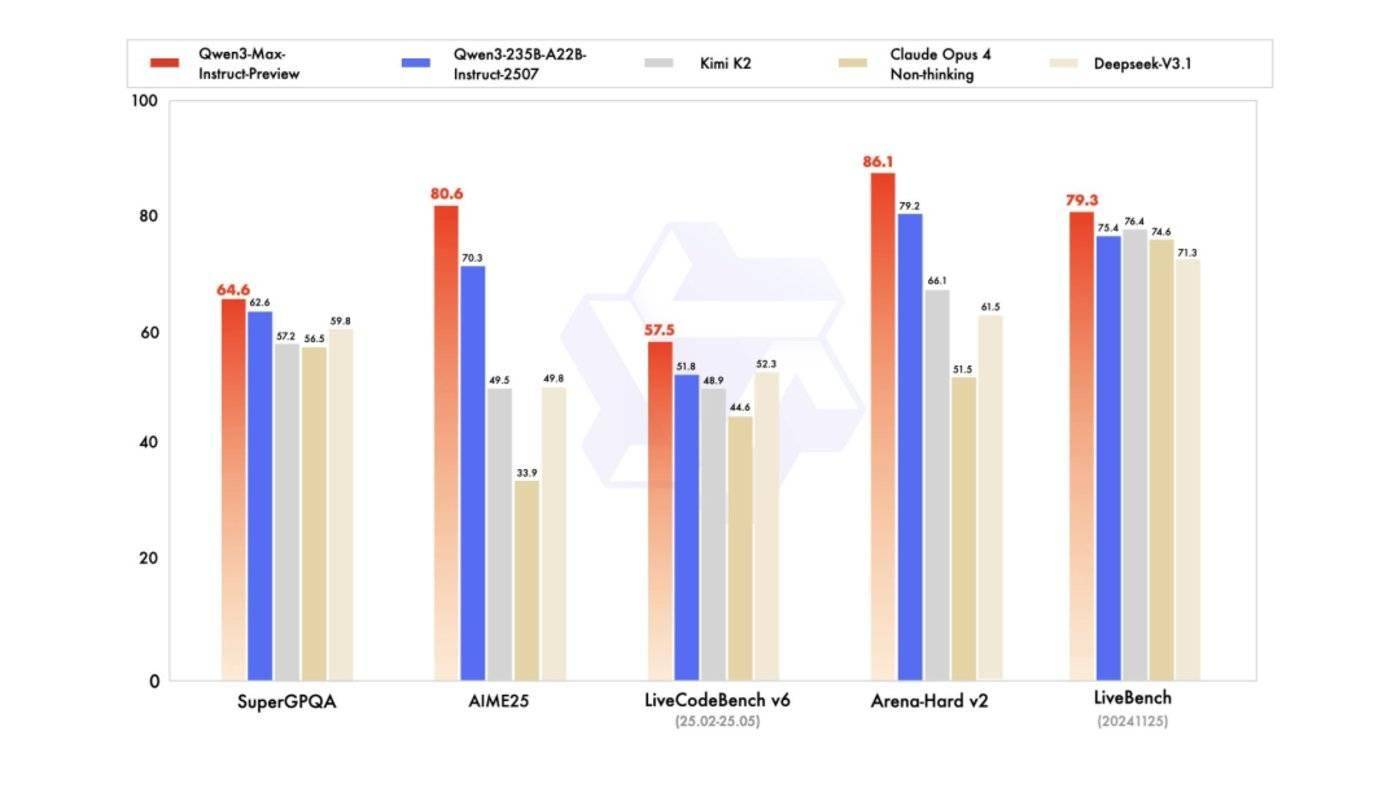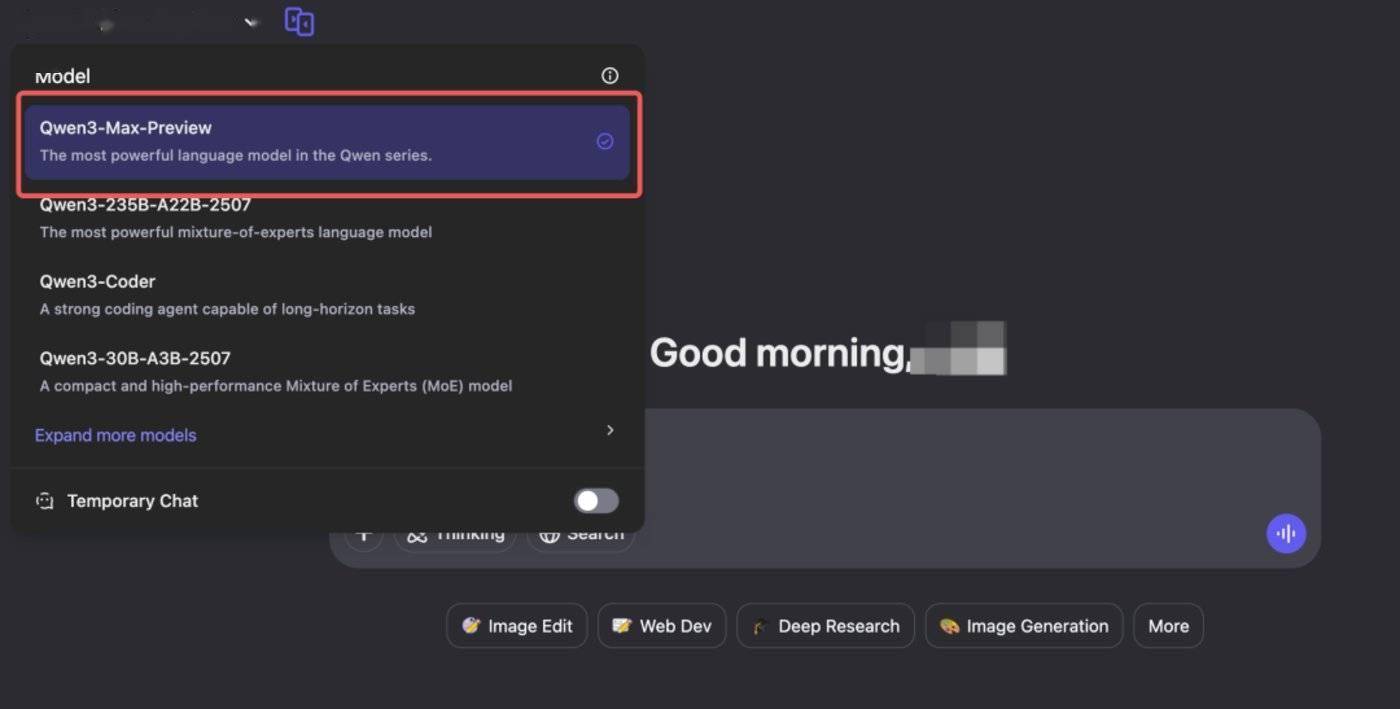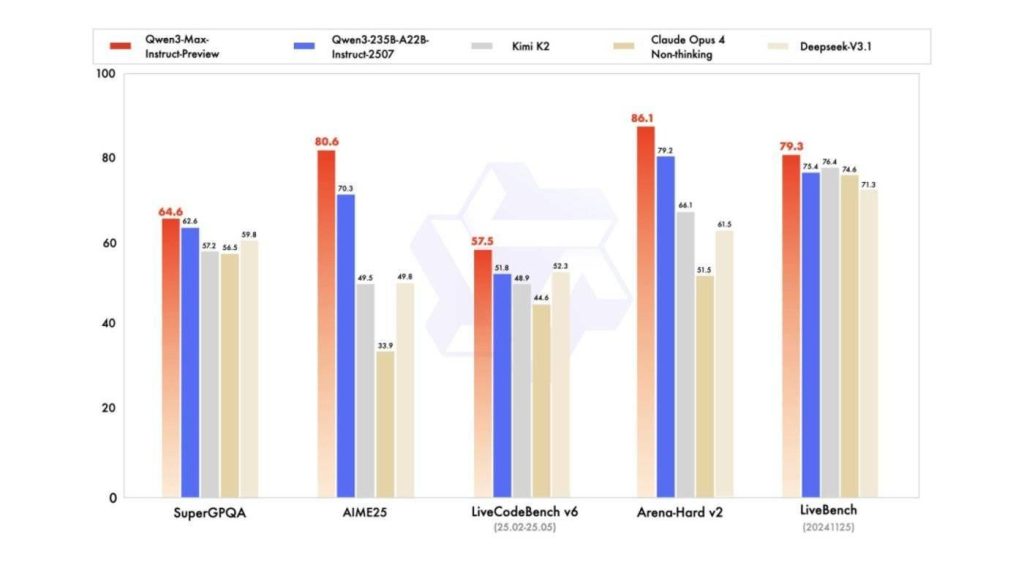1. Alibaba has released its largest model to date, surpassing one trillion parameters, with programming capabilities now exceeding Claude, proving that Scaling Law still works. 2. Alibaba’s “Model + Cloud” strategy has created the shortest path from technological research and development to commercial implementation, which is one of the key factors in Qwen’s success as a latecomer. 3. The core challenge of Alibaba’s open-source model lies in balancing openness and profitability. In the future, Qwen not only needs to continue technological breakthroughs but also must prove its value in business models and organizational capabilities.
Yesterday, Anthropic made an extreme move, and Alibaba retaliated late at night with a major announcement—launching its largest model ever, Qwen3-Max-Preview, with over one trillion parameters!
Using the official title from the “Tongyi Model” WeChat public account to describe its capabilities, it is “stronger than just a little.”
From the benchmark test results, Qwen3-Max-Preview has already surpassed its previous model, Qwen3-235B-A22B-2507.
Moreover, the official team has released comparison results with Kimi K2, Claude Opus 4 (Non-thinking), and DeepSeek-V3.1.
From the table below, it is evident that Qwen3-Max-Preview has outperformed other competitors in benchmark tests such as SuperGPQA, AIME2025, LiveCodeBench V6, Arena-Hard V2, and LiveBench.

Especially in programming capabilities, which were previously dominated by Claude, Qwen3-Max-Preview achieved a remarkable lead this time, leaving many netizens astonished.

Qwen’s post on X seems to reveal the “secret”: Scaling works.
01 Real-World Testing of Alibaba’s Largest Model
Currently, Qwen3-Max-Preview is available for experience; you just need to select it from the model dropdown menu:

Experience link: https://chat.qwen.ai
The official API service has also been opened: https://bailian.console.aliyun.com/?tab=model#/model-market (search for Qwen3-Max-Preview).
In terms of actual performance, many netizens from both domestic and international communities have started real-world testing. For example, well-known blogger AK on X integrated Qwen3-Max-Preview into the project AnyCoder on HuggingFace, entering the following prompt:
Design and create a very creative, elaborate, and detailed voxel art scene of a pagoda in a beautiful garden with trees, including some cherry blossoms. Make the scene impressive and varied and use colorful voxels. Use whatever libraries to get this done.
Then, according to AK’s deion, Qwen3-Max-Preview achieved the following effect in one go:
When we entered the following prompt on the official website:
Create a beautiful celebratory landing page for the launch of Qwen3 Max.
In just a few seconds, Qwen3-Max-Preview generated a complete celebration page, with a very fast response time:

Next, we increased the difficulty by posing a classic programming problem—simulating a bouncing ball collision.
We started with a simple one:
Write a java code that shows a ball bouncing inside a spinning hexagon. The ball should be affected by gravity and friction, and it must bounce off the rotating walls realistically, implement it in java and html.

As you can see, the ball moves based on physical laws within the hexagon; and when we use the “up arrow key” to apply force to the ball, it responds immediately.
When we set the number of balls to 10, the generated effect was also quite natural:

Finally, we asked Qwen3-Max-Preview to generate a mini-game:
Make a mini-game like “Angry Birds”.

Although it was successfully generated in one go, perhaps due to the simplicity of the prompt, the mini-game still has some minor flaws, such as the monster’s position not being very accurate; interested friends can try it multiple times.
02 Why Qwen Succeeded as a Latecomer?
From Alibaba’s leap from a hundred billion parameter model to a trillion scale (nearly a fourfold increase) and achieving first place in many assessments, Qwen has firmly established itself in the top tier globally.
However, to be fair, looking at the entire AI large model competition, Alibaba was not the first company in China to launch a product comparable to ChatGPT, but it is undoubtedly one of the latecomers who has surpassed expectations.
Compared to domestic pioneers (such as Baidu), Alibaba’s large model was relatively low-key in its early stages, but its path has been exceptionally clear—building an ecosystem through model open-sourcing while exploring technological frontiers with self-developed closed-source models.
For instance, in the area of open-source, starting from 2023, Qwen has been rapidly releasing multiple versions of models to global developers. From the 7 billion parameter Qwen-7B to 14 billion, 72 billion parameters, and then to visual, audio, and other multimodal models, it almost covers all mainstream sizes and application scenarios. More crucially, Alibaba not only open-sourced the model weights but also opened up commercial licensing, greatly stimulating enthusiasm among small and medium-sized enterprises and individual developers.
This series of actions has allowed it to quickly establish a broad influence in top global open-source communities like Hugging Face, attracting a large number of developers to innovate and develop around the Qwen ecosystem, forming a strong community driving force. This strategy of accumulating resources has earned Tongyi Qwen valuable developer mindshare and application scenario data, which is an advantage that closed-source models find hard to achieve.
But beyond open-sourcing, Alibaba has never ceased exploring the limits of model capabilities internally. As the official statement during the release of the trillion-parameter model said, Scaling works. Behind this is a strong belief in Scaling Law—an exponential increase in model parameters, data volume, and computing power will lead to a qualitative leap in model capabilities.
Training a trillion-parameter model like Qwen3 Max Preview is not merely about resource accumulation; it requires ultimate precision in every detail of stability in ultra-large-scale computing clusters, efficiency of distributed training algorithms, data processing finesse, and engineering optimization.
This is backed by Alibaba’s significant investments over the years in computing power infrastructure and deep accumulation in AI engineering. It is this saturation-level investment that has allowed Qwen to surpass top models like Claude Opus in core capabilities like programming and reasoning.
In addition to the open-source model and capability exploration, Alibaba Cloud is also a key factor in Qwen’s success as a latecomer.
After all, training and inferring large models is a well-known resource-intensive endeavor; Alibaba Cloud provides stable and efficient computing infrastructure for Qwen’s research and development, integrating the full-link tools from data labeling, model development, distributed training to deployment and inference, significantly reducing the engineering burden on R&D teams, allowing them to focus on algorithm and model innovation.
Moreover, regarding model application and popularization, due to Alibaba Cloud’s MaaS strategy, Qwen can quickly penetrate various industries; for instance, enterprise clients can call the Qwen API directly on Alibaba Cloud without training a model from scratch or fine-tune the open-source Qwen model using platform tools to quickly build AI applications.
This “Model + Cloud” strategy has created the shortest path from technological research and development to commercial implementation.
03 But It’s Not Perfect
Although Alibaba’s strategic choices in the development of large models have contributed to its advantages as a latecomer, this does not mean that the current state of Qwen is without risks.
Because Alibaba’s choice of open-source model to attract users and monetize cloud services can be seen as a path filled with both opportunities and challenges; it is similar to Meta’s Llama series, aiming to quickly capture market share and developer mindshare through an open ecosystem, ultimately directing commercial value to its own infrastructure.
This stands in stark contrast to the closed-source + API elite routes of OpenAI, Anthropic, and others, which have the advantage of better protecting core technology, maintaining technological generational differences, and directly generating high profits through high-value API services.
While Alibaba’s open-source strategy can quickly popularize technology, it also means that its most advanced models may struggle to create a significant gap from competitors, and the business model becomes more indirect, requiring clients to first recognize the value of its cloud platform.
The core challenge of the open-source model lies in balancing openness and profitability. When companies can obtain and privately deploy sufficiently good open-source models for free, how strong will their willingness be to pay for official cloud services?
In other words, Alibaba Cloud not only needs to provide simple model hosting but must also offer performance optimization, security guarantees, as well as a robust toolchain and enterprise-level services that far exceed the open-source versions, to build a sufficiently deep moat. How to effectively convert a large open-source user base into high-value paying cloud customers will be the most critical commercial leap on this path.
Aside from commercialization challenges, in today’s fiercely competitive environment for top AI talent, any loss of core personnel could have profound impacts on the team.
In recent years, some key technical talents, including Jia Yangqing in the AI framework and infrastructure field, have left Alibaba to join the entrepreneurial wave or other giants. Although for a company of Alibaba’s size, the departure of a few individuals may not shake its foundation, the negative impact still exists.
After all, the departure of core leaders may affect team morale, send negative signals externally, and increase the difficulty of attracting top talent in the future; changes in leadership in key technical directions may also introduce uncertainties into the long-term strategic continuity of projects.
Just like the ongoing talent war in Silicon Valley, where Meta is involved, the departing talents often become new competitors, fully aware of the strengths and weaknesses of the original system, potentially posing a more precise threat in niche areas.
Therefore, how Alibaba continues to maintain its appeal to top global AI talents under intense competition and establishes a stable and sustainable talent pipeline is a serious issue it must face in its future development.
Conclusion
Overall, Alibaba’s Tongyi Qwen is undoubtedly a top force in the field of large models in China and even globally. With its clear strategy of “parallel open-source and self-research,” backed by Alibaba Cloud’s powerful ecosystem and deep technical talent accumulation, it has successfully secured a leading position in intense competition. The release of the trillion-parameter model further demonstrates its determination and strength in Scaling Law.
However, the path to success is also accompanied by clear challenges. The business model of exchanging open-source for ecosystem still needs to be tested by the market for its sustainability; the pursuit of technological generational differences with closed-source giants like OpenAI will be a long process; and the retention and attraction of top talent is the lifeline for maintaining innovative vitality.
In the future, Qwen not only needs to continue breaking through technically but also must prove its unique value in business models and organizational capabilities. Whether it can transform today’s technological advantage into an unshakeable market dominance tomorrow will be a focal point of interest for the entire industry, including the capital market. This is also the key to whether Alibaba’s future market value can reach new heights.
1. https://x.com/Alibaba_Qwen/status/1963991502440562976
2. https://chat.qwen.ai/
3. https://x.com/_akhaliq/status/1964001592710975971返回搜狐,查看更多

